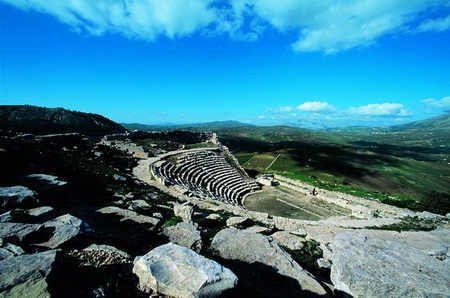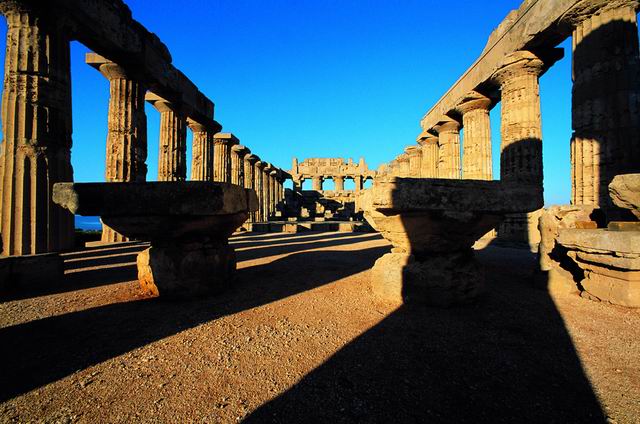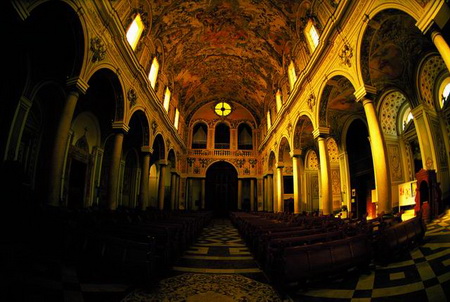| |||||
 |
Trapani: history, archaelogigy and myth | ||||
| In Sicily there are places where myth and history are firnly joined together and archaeological remains attest to the previous existence of ancient peoples and civilizations. | |||||
| Related images (1) |
|
On the top of Mount San Giuliano, among the silent clouds lies the town of Erice, overlooking Trapani from a superb scenic location. Erice was inhabited by the Elymians, who erected a temple dedicated to the worship of the godness of fecundity and love.
Next to it there are the Giardini del Balio, overlooked by medieval towers. The town is surrounded by cyclopean walls of Elymian origin (8th century BC), at whose corners stand the Norman castle, the Spanish quarter and the cathedral (dated 1314), which has manteined its original 12th century Gothic style in the bell tower and the delicate mullioned windows. The town planning of Erice's oldest part is primarily medieval in character, with little squares and narrow winding alleys opening onto lovely courtyeards full of flowers. In Erice there are more than 60 churches, including those of San Martino, San Cataldo, San Giuliano and San Giovanni Battista, which every summer resound with medieval music, revived by world-famous musicians during a festival called Settimana di musica medioevale e rinascimentale. The Cordici Museum in Piazza Umberto I is well worth a visit: in the hall there is a painting by Antonello Gagini, the “Annunciation”. Erice, which is also the seat of the Ettore Majorana Scientific Centre has fully maintained the fascinating atmosphere of an old medieval village, with its characteristics arts and crafts: finely decorated pottery, colourful hand-woven rugs and the traditional small cakes made of almond paste and candied fruit.
The 5th century Siculian-Doric temple stands imposingly on a hillock in the middle of a picturesque valley. The Greek theatre, carved in the rock and dated to the 2nd century BC, overlooks the valley from the top of Mount Barbaro. In the spectacular natural view provided by the steep slope over the valley of Segesta, every two years theatrical performances are staged during the festival Scena millenaria per i classici del mondo, evoking and atmosphere of older times. A large shrine dating back to the 4th-5th century BC provides the crowning touch to the archaeological park of Segesta, but more marvels are yet to be discovered. Current excavations are bringing new remains to light, thus testifying to Segesta's past grandeur. Just a few kilometres from Segesta, along the basin of the Freddo river lies Calatafimi, a town of ancient Arab origin and the setting of the famous historic battle betwen the Bourbons and Garibaldi's soldiers in 1860. Calatafimi has many notable buildings, including the partially destroyed Church of the Carmine, the Mother Church and the Church of the Crocifisso.
A succession of columns and remains of massive Greek temple, surrounded by the green countryside and the deep blue colour of the sea: this is Selinunte, situated near the mouth of the river where the wild celery (selinon) still grows and in the past gave its name to the town and the watercourse. Founded by the Greeks in the second half of the 7th century BC, Slinunte is one of the most relevant archaeological parks in the Mediterranean area. Its outstanding collection of remains is the fullest expression of the Sicilian civilization in the 4th and 5th centuries BC. The “C” temple is one of the oldest example of Doric Style and dates back to the first half of the 6th century BC, but the most enchanting of all remains is the “E” temple. It has been almost entirely reconstructed and its front part was adorned with some metopes representing figures. The old artistic tradition of Selinunte is attested by the original little statue of the Ephebus of Selinus. The acropolis, on which the old fortified town was built, is of remarkable artistic interest for the necropolis, the towers and the bridges. Many finds, including painted vases, metopes and bas-reliefs, are displayed at the Museum of Archaeology in Palermo. About ten kilometres west of Selinunte the builders of the past found the best stone to create their grandiose work. From the quarries of Cusa, today in the territory of Campobello di Mazara, a kind of limestone called calcarenite was dug out and used to build the huge capitals and the imposing columns of Selinunte's temples. A visit to the quarries gives the striking impression of being in a place where works have suddenly stopped. Everything seems to have remained as it were more than 2000 years ago.
From Selinunte one can easily reach Castelvetrano, situated in a valley between the Delia and Belice rivers. The town's old centre is marked by many palaces and churches of different styles, ranging from Reinassance influences to early Catalan Baroque. Buildings of great artistic relevance include: the Mother Church, with decorations by Gaspare Serpotta, the Church of San Domenico; the Church of Purgatorio, housing the Perosi Auditorium; the Selinus Theatre; the 13th century Palazzo Pignatelli and, the last but not least, the Arab-byzantine Church of the Trinità di Delia, also dated to the 13th century.
In Mazara there are numerous old monuments of various ages, from the 11th to the 18th century, such as for istance the Church of San Nicolò Regale and the remains of a Norman castle. The Baroque stylr has here many of its finest examples in the churches of Santa Veneranda and Sant'Ignazio and in the rectangular Piazza della Repubblica, with the Cathedral, the Seminary and the Episcopal Palace. The “Satiro Danzante” preserved in the homonymous museum (Sant'Egidio Church) is a masterpiece, dating back to the IV century BC, attributed to Prassitele. The bronze statue, about 3 mt tall, was found in the Sicilian Channel in 1998 and it was restored by technicians of the Central Institute for Restoration.
Texts and photos, gently permitted, are property of A.P.T. Trapani - www.apt.trapani.it
| |
 |
Search other Guides |
Related arguments
| Favignana |
| Levanzo |
| Marettimo |
| Pantelleria |
| “Via del Sale” - The salt road |
| The hinterland and Belice Valley |
| Through nature between land and sea |
| Trapani between islands and coral |
| Trapani: history, archaelogigy and myth |

 Munch: The Scream Within
Munch: The Scream WithinOne of the year’s most eagerly awaited exhibitions to open its doors on 14 September 2024: Edvard Munch is back in Milan with a major retrospective after a 40-year absence.
 In the garden
In the gardenThe initiative, which is scheduled to run from June 26th to September 13th, 2020, is inaugurating a temporary space for art in Corso Matteotti 5, in Milan, in the very heart of the city.
 Perugia Travel Guide
Perugia Travel GuidePerugia is the chief town of Umbria. This beautiful town is sited on a hill in the middle of a verdant country. His central square is considered one of the most beautiful squares of Italy and history, traditions, art and nature make a unique ensemble in this town as in the whole




.jpg) Successive invaders used this building to adore their own divinities: Tanit-Astarte for the Phoenicians, Aphrodite for the Greeks and Venus Erycina for the Romans. On the ruins of the temple stands the Castello di Venere, fortified during the Norman rule.
Successive invaders used this building to adore their own divinities: Tanit-Astarte for the Phoenicians, Aphrodite for the Greeks and Venus Erycina for the Romans. On the ruins of the temple stands the Castello di Venere, fortified during the Norman rule. Following the slope of Mount Erice and tracks of the ancient Elymian people one arrives in Segesta, surrounded by a range of gently sloping hills which enclose two precious jewels, the Temple and the Theatre.
Following the slope of Mount Erice and tracks of the ancient Elymian people one arrives in Segesta, surrounded by a range of gently sloping hills which enclose two precious jewels, the Temple and the Theatre. Segesta's history is inextricably intertwined with that of its arch-rival Selinunte, the ancient Slinus, another great town of the past.
Segesta's history is inextricably intertwined with that of its arch-rival Selinunte, the ancient Slinus, another great town of the past. The town of Mazara del Vallo lies on the left side of the mouth of the Mazzaro river, on the western coast of the island between Capo Boeo and Capo San Marco. It is an agricultural and fishing centre and its port gives shelter to the largest fishing fleet in Italy.
The town of Mazara del Vallo lies on the left side of the mouth of the Mazzaro river, on the western coast of the island between Capo Boeo and Capo San Marco. It is an agricultural and fishing centre and its port gives shelter to the largest fishing fleet in Italy.